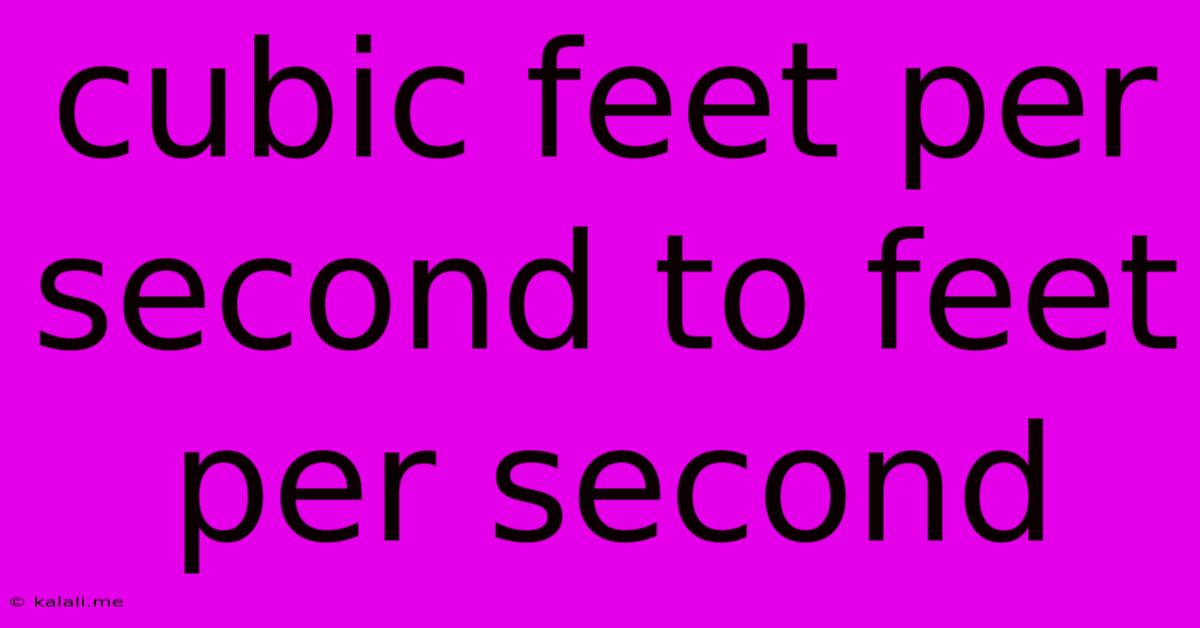Cubic Feet Per Second To Feet Per Second
Kalali
Jun 07, 2025 · 3 min read

Table of Contents
Cubic Feet Per Second (CFS) to Feet Per Second (FPS): Understanding the Difference
Understanding the difference between cubic feet per second (CFS) and feet per second (FPS) is crucial for anyone working with fluid dynamics, hydrology, or any field involving the measurement of water flow. While both units relate to flow, they measure fundamentally different aspects. This article will clarify the distinction, explain the conversion process (when possible), and explore common applications of each unit.
What is Cubic Feet Per Second (CFS)?
Cubic feet per second (CFS), also known as cumecs, measures the volume of a fluid (usually water) passing a specific point per second. Imagine a pipe; CFS tells you how much water flows through the pipe in one second. It's a three-dimensional measurement, accounting for length, width, and height of the water volume. This is a crucial measurement for understanding river discharge, irrigation systems, and water management in general. Think of it as the total amount of water flowing.
What is Feet Per Second (FPS)?
Feet per second (FPS) measures the speed or velocity of a fluid. Using the pipe analogy again, FPS tells you how fast the water is moving within the pipe. It's a one-dimensional measurement, focusing solely on the rate of movement. This is valuable for understanding the energy of the flow, the erosive power of a current, and the potential impact of moving water. Think of it as how quickly the water is moving.
The Key Difference: Volume vs. Velocity
The fundamental difference lies in what each unit measures: CFS measures volume, while FPS measures velocity. You cannot directly convert CFS to FPS without additional information. To illustrate: a small pipe can have a high FPS (fast-moving water) but a low CFS (small volume of water), while a large pipe can have a low FPS (slow-moving water) but a high CFS (large volume of water).
When Conversion Might Seem Possible (But Isn't)
Some might mistakenly assume a conversion is possible if dealing with a known cross-sectional area. While knowing the area of the channel or pipe helps, it doesn't directly equate to a conversion. To obtain the FPS, you need to know both the CFS and the cross-sectional area of the flow.
Calculating Velocity (FPS) from Flow Rate (CFS)
The formula for calculating the average velocity (FPS) from the flow rate (CFS) is:
FPS = CFS / Area
Where:
- CFS is the flow rate in cubic feet per second.
- Area is the cross-sectional area of the flow in square feet.
This formula only gives the average velocity. The actual velocity of the water will vary across the cross-section of the flow due to factors like friction and turbulence.
Examples of Applications
- Hydrology: CFS is essential for monitoring river discharge, predicting floods, and managing water resources. FPS can help determine the erosive power of a river and its potential impact on infrastructure.
- Irrigation: CFS is crucial for determining the amount of water needed for irrigation. FPS might be relevant for designing efficient irrigation systems.
- Hydraulic Engineering: Both CFS and FPS are vital for designing dams, canals, and other hydraulic structures. Understanding both aspects is crucial for accurate modeling and design.
In Conclusion
While both CFS and FPS are related to fluid flow, they measure different properties. CFS quantifies the volume of flow, while FPS represents the velocity of flow. Direct conversion is impossible without knowing the cross-sectional area. Understanding this difference is paramount for anyone working with fluid dynamics, ensuring accurate calculations and informed decision-making.
Latest Posts
Latest Posts
-
Amc Number Theory Problems Number Bases
Jun 07, 2025
-
How Long Does It Take Deck Stain To Dry
Jun 07, 2025
-
How To Find Key Of Song
Jun 07, 2025
-
If I Replace A Bed Will The Person Spawn Still
Jun 07, 2025
-
Virtual Machine Transfer Files Without Shared Folder
Jun 07, 2025
Related Post
Thank you for visiting our website which covers about Cubic Feet Per Second To Feet Per Second . We hope the information provided has been useful to you. Feel free to contact us if you have any questions or need further assistance. See you next time and don't miss to bookmark.